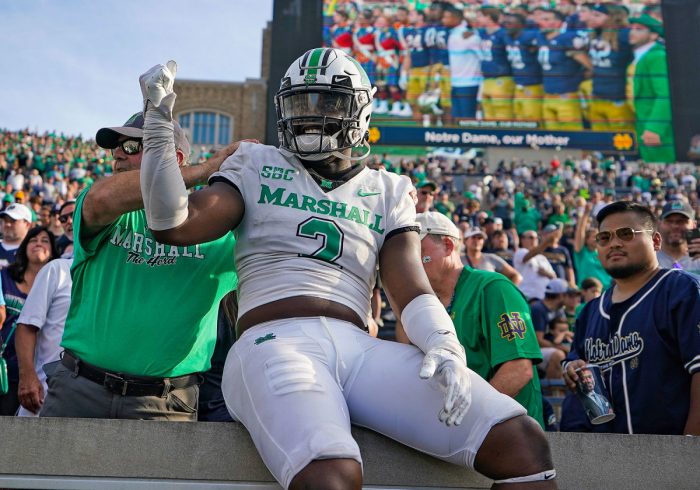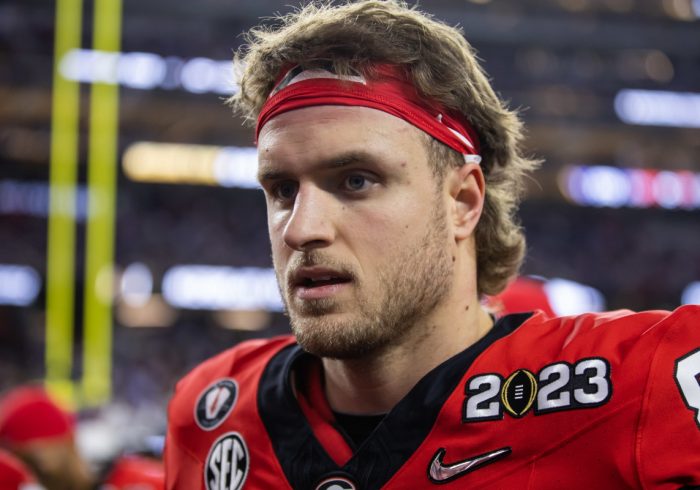Kelee Ringo, Brock Bowers, Darnell Washington and Kendall Milton all have something in common: They are West Coast guys playing for a school in the Deep South.
On Monday, when their Georgia Bulldogs meet TCU in the national championship game, the four players can help continue a reign of dominance unseen in the history of the sport: No matter what happens Monday, teams from the Southeastern region of the United States or the state of Texas will have won 17 of the last 18 college football titles.
The latest championship will unfold within $6 billion SoFi Stadium located in the heart of the West Coast’s crown jewel, Los Angeles. The South and Texas are here to plant their proverbial flag: They own the sport.
“The SEC and the South,” says a smiling Ringo. “A lot of people in the South live, eat and breathe college football. That’s different on the West Coast.”
Georgia is going for its second straight national championship after winning the Peach Bowl.
Adam Cairns/Columbus Dispatch/USA TODAY Network
Ringo, Georgia’s All-SEC second team defensive back, is from Tacoma, Wash.; Bowers, arguably the nation’s best tight end, is from Napa, Calif.; Washington, the 6-7 foot tight end, is from Los Angeles; and Milton, the Bulldogs third-leading rusher, is from Fresno.
All integral to Georgia’s second consecutive march to the national championship game, the four players chose to compete for an SEC team three time zones and more than 2,000 miles away from home. It is a microcosm of a bigger trend: The South, already chock full of the country’s best football talent, is swiping the best players from other regions as well and using them all to dominate the landscape.
Now back in their native Pacific Time Zone, Ringo, Bowers, Washington and Milton can deliver yet another blow to the idea that college football is a national sport. One region—six states—have a stranglehold on this thing.
Nine different schools have won the last 17 national titles. Eight are located in the Southeast or Texas and are responsible for 16 championships: Alabama (six titles), Clemson (two), LSU (two), Florida (two), Georgia, Auburn, Florida State and Texas. The outlier is Ohio State’s 2014 national championship.
“All of us West Coast guys, we kind of realized that the best ball is being played now down in the South,” says receiver Nathan Priestley, another West Coast player on Georgia’s team who hails from Burbank, Calif. “How football is played down in the South. It’s different.
“I don’t want to knock on the West Coast. We have great football, but [the South] just cares a little more. When the SEC says it means more, it actually does. I think people truly see that when they take visits down South.”
Alabama’s rise under coach Nick Saban coincides with its conference’s elevation as the dominant force in the sport. From 2006 to ’12, the SEC won seven straight championships, and the league has won four of the last five.
If you’re looking for a reason, turn to recruiting. From 2011 to ’21, the SEC’s 11-state footprint produced 197 five-star prospects. The other 39 states have churned out 134. Their recruiting footprint has led to on-field success.
On top of that, they are plucking some of the best Midwest and West Coast athletes to plug any holes. Take Bowers for example. A highly-rated prospect from northern California, his parents took him on a multi-day trip to visit six schools West of the Mississippi River: Penn State, Notre Dame, Michigan, LSU, Georgia and Clemson.
After the trip, he told his parents that while he hadn’t yet made a decision on where he’d attend school, he knew one thing.
“We left the trip and he said, ‘I can’t play on the West Coast. It’s just not the same over there,’” says Warren Bowers, Brock’s father.
“People take college football a lot more seriously in the South,” says Brock Bowers. “That was the reason for it.”
The South and Texas’s grip on the sport has left the parity, what little there ever was, severely diminished. The Horned Frogs (13–1) can rock the parity boat with a victory Monday night.
Over the last two decades, a small group of teams has dominated the game, and in the College Football Playoff era, an even smaller group controls the sport. Parity, never too pronounced in the annals of college football anyhow, feels nearly lost today, on the verge of extinction.
Since 1998, the first year of the BCS, when college football’s champion was crowned on the field and not in the polls, six teams have won 74% of the championships: Alabama (six), LSU (three), Clemson (two), Florida State (two), Florida (two) and Ohio State (two). If Georgia wins Monday, seven teams will have won 80% of the titles—a striking figure.
Gold trophies are the nine schools that won 17 titles from 2005 to ’21. Blue trophies are the seven schools that won 12 titles from 1966 to ’77.
In recruiting, technology has only widened the gap between the haves and have nots. Over the years, recruiting has moved from local to regional to, now, national. Big brands are using their resources and following on social media platforms to crack into a recruit’s home hundreds of miles from their own campus.
Georgia is a shining example.
“It’s always been a haves and have nots business,” says Gerry DiNardo, the former longtime major college coach who is now an analyst for the Big Ten Network.
The haves excel on the recruiting trail, selling prospects on their lavish facilities, large fan bases and winning tradition. And while the NFL has built-in parity with the draft— the best teams from the year before get the last picks each round—college football is quite the opposite.
“It’s almost unfair,” says former Florida coach Steve Spurrier, whose 1996 Gators are the last first-time national champion. “At Alabama, it’s like being in the NFL, winning the Super Bowl and every year getting the first 10 picks in the first round.”
It’s a cycle, industry experts say, and it’s not exclusive to Alabama: a big brand recruits well, wins a title, becomes an even bigger brand, recruits even better, wins more titles.
“If you win a championship in the NFL, you’re picking last,” says former Stanford coach David Shaw. “If you win the championship in college football, you’re picking first. There’s nothing that helps the people in the middle get to the top other than recruiting the right guys, maybe recruiting players who are better than others think they are.”
And then there’s TCU, a small private college that’s on a magical ride to the title game. The Horned Frogs defy recruiting projections of success. For instance, over the last four years, they have signed one five-star rated prospect. Georgia has signed 18.
“This is why we expanded the Playoff,” says Big 12 commissioner Brett Yormark. “It will give opportunities to more teams like TCU.”
The 12-team expanded Playoff is scheduled to start in 2024, but CFP expansion isn’t the only monumental change in the landscape of NCAA sports that may bring more parity. College athletes can now profit from the name, image and likeness (NIL). They can also transfer and play immediately at least once in their careers.
Though coaches and administrators incessantly complain about the flurry of player movement in the college game today, it has spread out talent. TCU starts five new transfers on defense, for example.
More than a year ago, Miami coach Mario Cristobal saw this coming. A school that is one or two spots short of a championship-caliber team can dip into the transfer portal, sign a player and immediately plug him into the hole.
“A lot of teams are gaining ground that way,” Cristobal said.
Meanwhile, teams from the Southeast and Texas will continue their grip on this sport’s national titles no matter the result Monday. But it hasn’t always been this way. In fact, from 1966 to ’77, 11 of 12 national champions hailed from outside of the South and Texas. Notre Dame won three titles. USC, Nebraska and Oklahoma claimed two. Pitt and Ohio State each won a championship as well.
Maybe the sport is like a pendulum, swinging from one region to the next every few decades?
Or maybe not.



